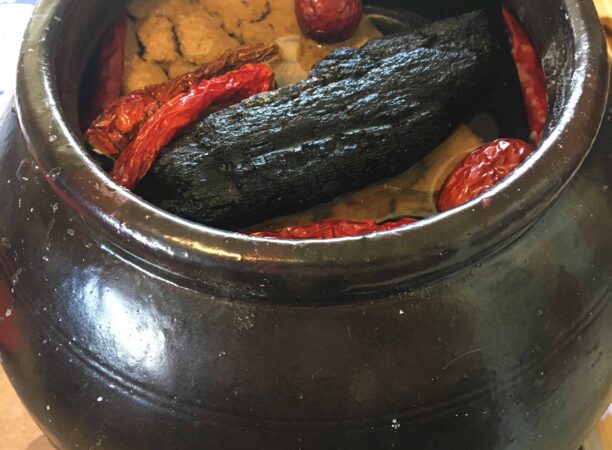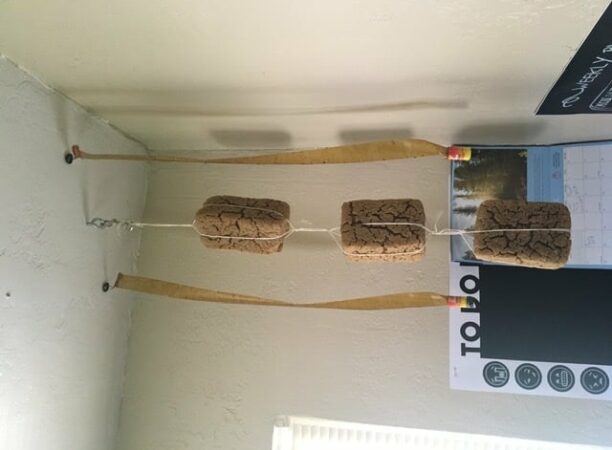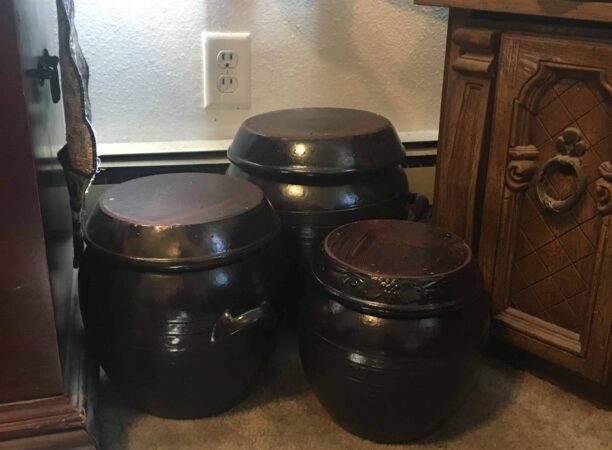Krn827
Forum Replies Created
- AuthorPosts
Krn827
ParticipantIf I know I won’t use a lot I buy the smallest tubs. That may help a little. I’ve never experienced mold yet and I’ve had my gochujang sit for a long time once before. However I noticed the slight hardening and change in coloration over time in both pastes. I put a plastic seal on top before closing the lid to help because I notice the lids are not airtight. So far it seems to help. Maybe also try changing the location of where it sits in your fridge too. I have a bottom freezer fridge. I place both my pastes on the top shelf in the fridge kind of close to the ice maker. I notice some things tend to freeze near my ice maker so maybe having my pastes close to it keep it even cooler. I’ve never thought of freezing my pastes because I use them all the time. It’s worth experimenting with a little bit though especially if your experiencing mold issues. Hope that was a little helpful.
Update on my homemade doenjang…once I took them out of the hay box there was absolutely no difference so I knew they were ready for the brine. So for my Idaho climate, it only took half the time to dry than Maangchi’s recipe (6-8weeks). Everything’s looking good and it is so worth the investment to get the Korean ongi. My Kimchi has been even more amazing (I use Maangchi’s recipe for that too). Proud to say I would make a good Korean housewife. ;)
Krn827
ParticipantI get frustrated when I try to use forums to answer my questions, and no one ever responds. So I will try my best to help. According to Maangchi, and I recommend watching some other videos; pink, yellow, greenish, are all okay fungus. White is ideal. As long as it continues to get that crackly dry look with your fungus you’re doing good. What you don’t want is black with a slimy, not drying, rotting look. It’s all about what’s in your air. Where you live and your drying/climate conditions matter. I live in a high, thin, dry air climate in the country, so it was good I started drying my meju in spring so our rains helped with humidity and we still have cool weather (I’ve read some people have problems with no fungus growing at all because of lack of humidity). The heat source I ended up getting was a heating pad for pets and is perfect. It doesn’t get too hot and I used kind of a combo of tin foil and a kitchen towel instead of wax paper to help with controlling heat. Rotating your meju like Maangchi suggests is important too. Eventually it will dry enough to hang. When I hung my meju I did it in my kitchen corner which ended up being really smart to do because cooking in the kitchen kept some humidity in the air and I have a ceiling fan for ventilation. If I didn’t have the fan I probably would have got a desk fan to blow towards them (helps with smell and bugs too) Other Korean videos have shown some meju hanging with a small wrapped bundle of straw, or what hangs the meju is made of straw. That’s something to try, if you can, to help make sure the correct bacteria is in the air for good fungus growth. I have horses and live in the country so my air is already full of what my meju needs and I’ve had really nice white fungal growth. I love trying to figure out the science behind doenjang. I think the green, yellow, or pink people mention is all about the balance of humidity, heat, and what bacteria is in the air when drying your meju. I got lucky for my first time and started with a good balance before I understood what to look for. I’ve read and seen a lot of meju not turn out or worry people because you have to do a little bit of science homework to understand what your meju is going to do, and even then you worry about it because they do become your babies.;)
My question that I would love answered is: how do I know when my meju is ready for the brine? I’m at week 7 and according to Maangchi’s recipe, is in the hay box. However, my meju is so dry I can see through from one side to the other. I should still have another month or so to dry, but like I said earlier, I think my high elevation has dried them faster than places like Korea or New York that are at sea level. Hmmmmm So until someone hopefully has an answer for me I’ll have them in the box with hay for the 2 weeks, and if they are exactly the same as before they went in then I guess it will mean they’re done and ready for brine.
Krn827
ParticipantWell this is embarrassing. I realized yesterday that my math was wrong. I calculated 2 1/2 gallons in my previous comment. So the ratio I got for 3 1/2 gallons water (or 56 cups) to 20 cups salt is actually 2 4/5:1 so almost 3:1. Sorry, like I said , my husband is the math teacher, not me.;) So far my meju looks good. I like knowing the science behind recipes like this so, I researched more and discovered that mold and bugs go together so they are called fungus gnats that hang out around my meju. My solution was to hang fly tape nearby and that works pretty good. Also hydrogen peroxide helps but don’t spray it on your meju. I would spritz my walls and ceiling around it though. There is also a homemade vinegar, sugar, soap mix that actually works a little. I tried a cheese cloth but it only trapped the gnats in so I took it off once I knew my meju was dry enough that flies wouldn’t be a problem for making maggots. With all this experimenting I did find that having a fan with lots of circulating air is key, especially to reduce the smell (that’s a little bit like an outhouse to me). Not sure why photo came out rotated.
Krn827
ParticipantI hope I can help a little with other questions. You need to just invest in a Korean fermenting crock. Like many others, I was hoping for an alternative solution and my research came up with nothing good enough. I even research German crocks and they are not quite the same either. I did eventually find an excellent website with the most reasonable prices, a variety of sizes, and excellent shipping for Korean crocks. The sight is eKitchenary.com They have four different size Korean crocks. The largest holds 11 liters or almost 3 gallons. I ended up buying 3 different sizes, and love them. If anyone knows of a good online store that sells at a good cost, a larger size than that, please share.
As far as brine ratio, I just did the math according to Maangchis recipe which is 10 quarts (or 3 1/2 gls) water to 5 quarts kosher salt if you did the 5lbs of soy beans. So that’s 40 cups of water to 20 cups kosher salt. Break it down more, it’s 2 cups water to 1 cup kosher salt, 2:1. (Sorry my husband is a math teacher.) Check my math but, but seems right. I don’t know ratio if trying iodine (“table”) salt, but I’m sure it’s easy to research.
Hope this was helpful.Krn827
ParticipantI am not new to Korean food, but new to forums. Hopefully this will help with my questions. I would like to know others thoughts on having gnat problems when drying their meju. I found some comments somewhere on this site about bugs being an issue, but no real satisfying answer to whether it’s common and to expect it or if they’re a sign of something else going on that I could control. Thanks
- AuthorPosts





